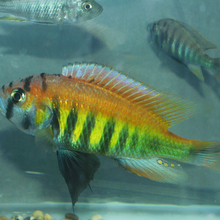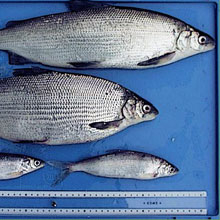Staff
Ole Seehausen


Prof. Dr. Ole Seehausen
About Me
Department Head, Eawag Fish Ecology and Evolution, Eawag Center for Ecology, Evolution & Biogeochemistry (CEEB)
Director, Institute of Ecology & Evolution (IEE), University of Bern
Division Head, Aquatic Ecology & Evolution, IEE, University of Bern
Academic & research interests
I am an evolutionary ecologist. I am keen to understand the evolutionary processes and ecological mechanisms by which biological diversity arises, those by which it is maintained and those by which it is lost. I am studying natural and sexual selection, gene flow and interspecific hybridisation, species interactions, evolutionary constraints and historical contingency. I want to know how these affect variation within populations and between populations, phenotypic polymorphisms, speciation, adaptive radiation, species assemblages and macro-ecological patterns. I also want to know how better understanding these processes can benefit nature conservancy.
I have studied the large adaptive radiations of cichlid fish in African lakes for more than 25 years, especially the radiations in Lake Victoria and smaller lakes in Tanzania and Uganda, and in the Zambezi region of southern Africa. More than 1000 species have emerged in these radiations in the past 3 or 4 million years, and more than 500 in Lake Victoria alone within the last 100'000 years or less. These are the largest and fastest adaptive radiations known in the animal kingdom and understanding them will be important for understanding the origin of species diversity in general. But cichlid fish are also well suited for experimental work in laboratory aquaria. Unfortunately , cichlids also experienced the fastest large scale extinction event ever observed by humans. Due to eutrophication of Lake Victoria, and the arrival of a non-native predator and competitor, perhaps as many as 200 endemic cichlid species disappeared in the past 30 years. Taken together, these three facts make cichlids perhaps the best vertebrate model organism for studying the origins, maintenance and loss of species diversity. It is also a great system to study the effects of species diversity and its loss on ecosystems because in each of the large African lakes, entire multi-trophic fish communities have evolved from scratch through adaptive radiation, including three or four different trophic levels. This is unparalleled in other recent fish radiations.
After moving to Switzerland in 2004, I established a second research program - parallel to the African cichlids - to investigate adaptive radiations of fish in the postglacial subalpine lake system of the European Alps. Switzerland alone has an impressive radiation of more than 30 endemic species of whitefish (Coregonus spp) most of which originated in the past 15,000 years. Like in the African cichlids, it appears that most larger lakes gave rise to their own endemic radiations, allowing for comparative analysis of speciation and adaptation between replicate radiations. Sadly, the whitefish radiations - much like Lake Victoria cichlids - are also an example of rapid recent mass extinction. My students and I showed that more than 30% of the endemic whitefish diversity of Switzerland has been lost in the past few decades. Our comparative analysis of extinction revealed that eutrophication of lakes is to blame. It reduced the diversity of reproductive and ecological niches and made distinct species collapse into hybrid populations. Most recently I have extended this research program to Alpine char (Salvelinus spp) that have diversified and gone extinct again in parallel with the whitefish in the same lakes.
In Switzerland I also started working on Threespined stickleback (Gasterosteus spp), a fish that fascinates me since my youth. A little indigenous population around Basel aside, stickleback only arrived in Switzerland in the 1870s. Yet, my students and I documented phenotypically and genetically very diverse types of stickleback in and around all larger midland lakes and some smaller lakes. We reconstructed the invasion history which involved three invasion fronts that met and mixed in the middle west of Switzerland. We now use this system to study the contemporary evolution of invasive species.
Using cichlid fish, stickleback, salmon-like fish and other species, students and Postdoctoral researchers in my research group address conceptual issues of broader relevance to the understanding of causes of variation in biodiversity. Such issues include the manifold interactions between historical contingency and ecological determinism that make biology so different from physics and chemistry, the role of interspecific hybridization, and the effects of speciation and adaptive radiation on ecosystems. To address these issues we combine methods from ecology, behavioral biology, experimental genetics, molecular population genetics and population genomics , phylogenomics and comparative methods.
Students and Postdoctoral researchers who come with their own ideas, questions and study systems are always welcome in my group.
Publications
Eawag Publications
[[ element.title ]]
Projects
[[ element.title ]]
Curriculum Vitae
| [[ entry.date || 'empty' ]] |
[[ element.title ]]
Publications
[[item.title]]
[[ element.title ]]
[[ element.title ]]
Address
| E-Mail: | ole.seehausen@cluttereawag.ch |
| Phone: | +41 58 765 2121 |
| Fax: | +41 58 765 2168 |
| Address: | Eawag
Seestrasse 79 6047 Kastanienbaum |
| Office: | SL B16 |
[[ element.title ]]
[[ element.title ]]
Expert on
[[ element.title ]]
[[ element.title ]]
Focalpoints
evolution
speciation
adaptive radiation
biological invasion
extinction
biodiversity
conservation
population genomics








